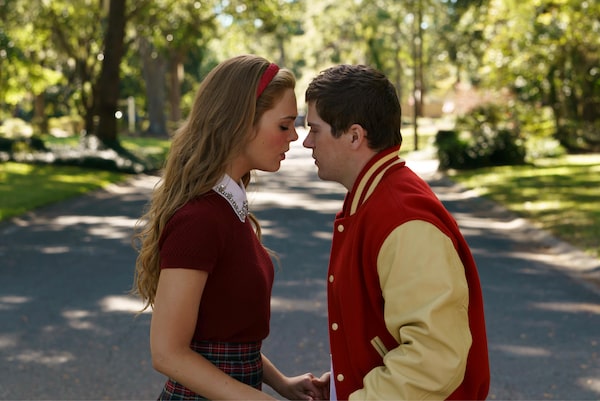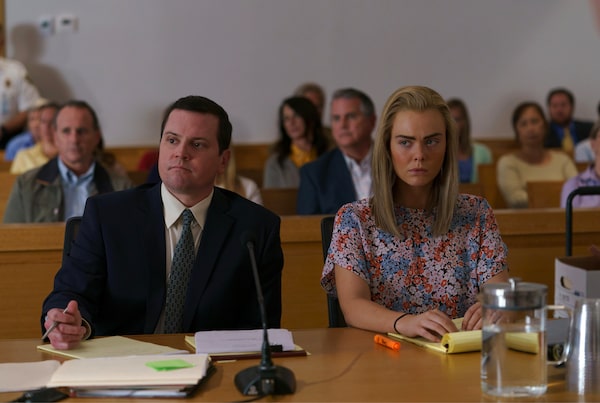
The Girl From Plainville is inspired by the true story of Michelle Carter’s controversial 'texting-suicide' case.Steve Dietl/UCP / Courtesy of W Channel
It looked like a cut-and-dried case. And it seemed drenched in something ugly and disturbing. You really didn’t want to know a whole lot more. Only that a judge had found the accused guilty and sentenced her to jail time.
The case was the 2014 death by suicide of 18-year-old Conrad Roy. It received international attention because the accused was 17-year-old Michelle Carter, Roy’s girlfriend, who was alleged to have sent him many texts and messages encouraging him to kill himself. Carter was convicted on an involuntary-manslaughter charge.
The Girl from Plainville (starts airing Thursday, W channel, 9 p.m.; also streaming on StackTV) is a six-part dramatization of the case. If you’re thinking shabby true-crime re-enactment, think again. Coming to Canada after an acclaimed run on Hulu in the U.S., the series – episodes arrive weekly – is formidably well done and a seriously deep-dive into the adolescent culture of cultivating tragic love.
Creators Liz Hannah and Patrick MacManus steer away from sensationalizing the story and handle the mental-health issues in the case with the gravity demanded by the details. There are also many on-screen invocations to seek help for such issues.
Catch up on the best streaming TV of 2021 with our holiday guide
The two lead actors are astounding. Elle Fanning plays Michelle, in a deeply controlled and focused performance, a million miles from her deliciously punchy work as Russian Empress Catherine II in The Great. Colton Ryan plays Conrad (Coco) Roy with a lowkey intensity that makes your heart break.

Creators Liz Hannah and Patrick MacManus steer away from sensationalizing the story and handle the mental-health issues in the case with the gravity demanded by the details.Steve Dietl/UCP / Courtesy of W Channel
The series is also extremely clever in how it manages to dramatize what happened mainly online. Some complexity and depth are necessary from the get-go because, when the case went to trial, it was heard by a judge only, not by jury, and Michelle declined to testify. You, the viewer, are asked to be the jury.
The story opens with Conrad missing and his worried mother (Chloë Sevigny in her best work in years) informing the police. The young man’s body is found. He died by poisoning himself with carbon monoxide fumes in his truck. Then we meet Michelle, who is in tears and shaking, telling her parents that Conrad is dead. Her mother and father have the same question: “Who?”
Neither family really knew about the relationship. Michelle and the teenage boy affectionately called Coco had met while both families were on vacation in Florida. The pair hadn’t spent much time together there, but as we see, they had an intensely involved attraction. Both socially awkward, both with mental-health struggles, both taking medication for the illnesses that the adults thought of as teenage woes.
They both lived in Massachusetts but an hour apart, and with Michelle at school and Coco working, they didn’t see each other. Instead, over several months they communicated by text messaging and occasional phone calls. The online relationship was private and excruciatingly agitated. They talked about depression and increasingly about death being the escape from all their worries. When the detective investigating Coco’s death gets access to his phone and reads all those messages, he’s astounded. He’s a middle-aged guy struggling to understand contemporary adolescent angst.

The series is extremely clever in how it manages to dramatize what happened mainly online.Steve Dietl/UCP / Courtesy of W Channel
In the aftermath of the death, no one understands what’s happening. Michelle’s friends are perplexed and put off by the frenzy of her grief – they, too, had never heard about the boy. Coco’s family are too lost in their own grief to see that Michelle’s intensity is deeply strange.
The ending to the first episode is one of the creepiest scenes this critic has seen in a long time. Michelle is preparing herself to be the grieving girlfriend. It’s like she’s rehearsing for a role. And she’s got a script for that: It’s a scene from the series Glee in which Lea Michele’s character Rachel Berry is talking with trembling regret about the death of a character on the show. As Michelle Carter and fans of Glee know, Lea Michele is really talking about the death of her boyfriend and castmate Cory Monteith. You don’t even have to know the full background to find it profoundly unsettling to watch.
While that scene from The Girl from Plainsville telegraphs something darkly superficial about Michelle Carter, the remaining episodes treat her mental state with a nuance that’s highly unusual. In the scenes between Michelle and Coco in Florida are delicately sweet, and then there is the drop-by-drop insinuation of Michelle’s obsession with stories of ruinous love and her crushing anxieties.
You could say Conrad Roy, a teen in a delicate mental state, just happened to meet Michelle Carter, equally delicate mentally but also compulsively drawn to imagined tragedy, and the alchemy was catastrophic. Or you can take other conclusions from this poignant, unnerving series.
Plan your screen time with the weekly What to Watch newsletter. Sign up today.